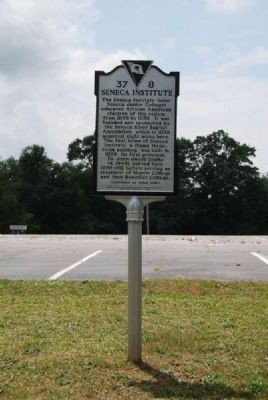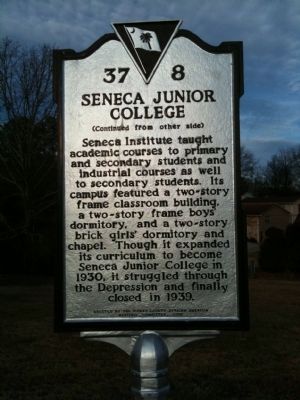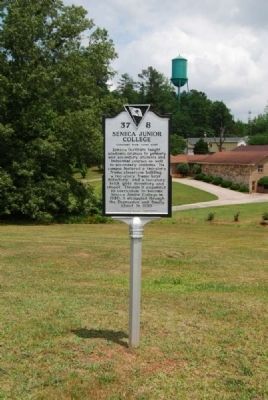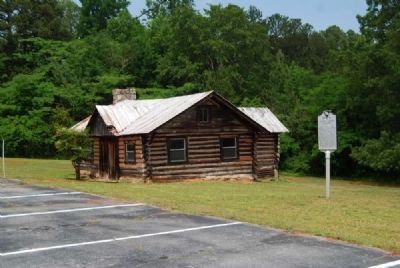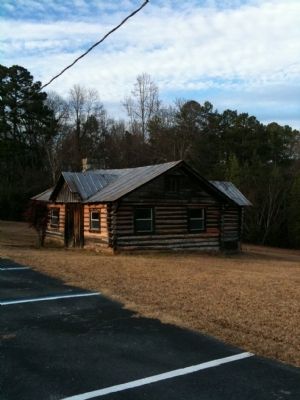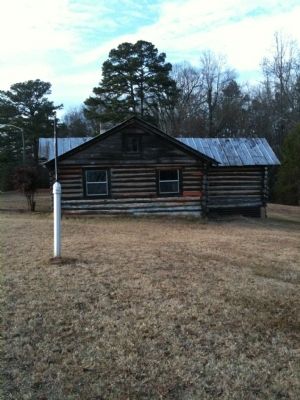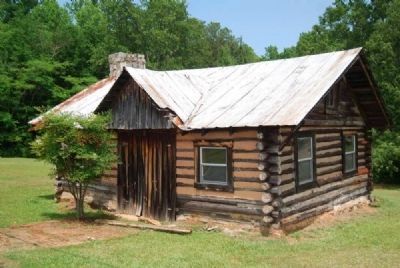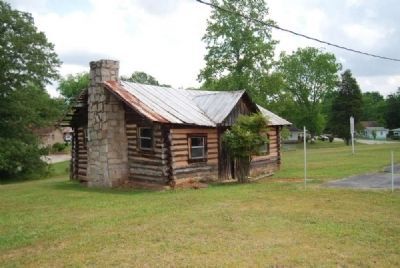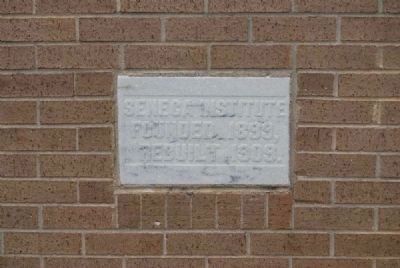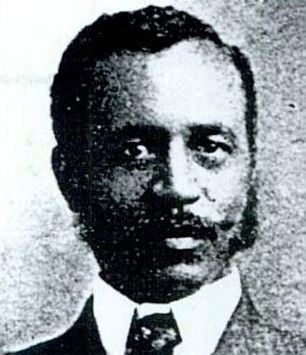Seneca in Oconee County, South Carolina — The American South (South Atlantic)
Seneca Institute / Seneca Junior College
Inscription.
Marker Front:
Marker Reverse:
Erected 2006 by the Oconee County African American Heritage Committee. (Marker Number 37-8.)
Topics and series. This historical marker is listed in these topic lists: African Americans • Education. In addition, it is included in the Historically Black Colleges and Universities series list. A significant historical year for this entry is 1899.
Location. 34° 40.838′ N, 82° 57.571′ W. Marker is in Seneca, South Carolina, in Oconee County. Marker is at the intersection of South Poplar Street and West South 3rd Street on South Poplar Street. Touch for map. Marker is in this post office area: Seneca SC 29678, United States of America. Touch for directions.
Other nearby markers. At least 8 other markers are within 2 miles of this marker, measured as the crow flies. Seneca (approx. 0.4 miles away); Seneca Firsts (approx. 0.4 miles away); Wall of Honor (approx. half a mile away); First Soil Conservation District Plan (approx. 0.6 miles away); Memorial Gateway (approx. 0.6 miles away); Fairplay Community Veterans Memorial (approx. ¾ mile away); Oconee County Training School (approx. 0.9 miles away); Oconee County World War Veterans (approx. 1.1 miles away). Touch for a list and map of all markers in Seneca.
Related marker. Click here for another marker that is related to this marker. The Visanska-Starks House in Columbia, SC.
Also see . . .
1. Seneca Institute - Seneca Junior College. The Seneca Institute - Seneca Junior College was an African-American school in Seneca, South Carolina from 1899 to 1939. (Submitted on May 7, 2012, by Brian Scott of Anderson, South Carolina.)
2. Morris College. Morris College (MC), located in Sumter, South Carolina, is a four-year, coeducational, liberal arts, private, historically black college founded and operated by the Baptist Educational and Missionary Convention of South Carolina. (Submitted on May 7, 2012, by Brian Scott of Anderson, South Carolina.)
3. Benedict College. Benedict College is a historically black, liberal arts college located in Columbia, South Carolina. (Submitted on May 7, 2012, by Brian Scott of Anderson, South Carolina.)
Additional commentary.
1. Rev. John Jacob Starks, D.D.
It's a far cry from the little Greenwood county farm to the presidency of a great denominational college, yet Rev. John Jacob Starks, D.D., President of Morris College, at Sumter, covered the distance at forty and filled the years between with fruitful religious service and with effective and constructive endeavor along educational lines. He early saw the importance of correlating the forces which make for character and the forces which make for intelligence, and had made a fight from the beginning of his ministry to keep religion and education going hand in hand. Accordingly his voice has been heard in every part of the State and his influence felt throughout the denomination.
He was born
on a farm in Greenwood county, April 14, 1872. His father, Eli Starks, was a farmer and was the son of Edmond Starks, a native African. His mother, before her marriage, was Flora Jones, who was a daughter of her master.
Young Starks grew up on the farm and attended the neighborhood school. At the age of sixteen he was converted and joined the Baptist church. Almost immediately he felt called to the work of the ministry. It was ten years later, however, before he was ready to take up the work. He showed his appreciation of the importance of the work ahead of him as a religious leader by devoting these years to a thorough preparation of himself for the task. Young men ambitious and impatient sometimes forget the example of the Master, who spent thirty years in preparation for three years work in the world.
Dr. Starks, after leaving the rural school, went to Brewer Normal at Greenwood. He then matriculated in the English course at Benedict College and completed the course in 1891. After then he took the regular college course at Morehouse, winning his Bachelor's degree in 1898. He did his theological work at the same institute from which he (1909) has the D.D. degree.
He was ordained to the full work of the ministry in 1898. His first pastorate was the Dunn Creek church, which he served two years. After that he pastored Ebenezer, at Seneca, six years, Canaan, ten years, and Pleasant Hill, at Westminster, four years. He was a pioneer in the establishment of associational schools and built the Seneca Institute, at Seneca, and established the work firmly before leaving Seneca for his present position. It is not putting it too strongly to state that the Seneca Baptist Institute is a monument to the foresight, energy and capacity of Dr. Starks.
In 1912 he was called to the presidency of Morris College at Sumter. The progress and development of the institution under his administration, proclaim the man at the head. Buildings and equipment have been increased, the faculty greatly strengthened and nearly trebled in number, while the income and attendance have grown apace and the institution under the leadership of Dr. Starks is making for itself a large place in the life of the denomination.
Dr. Starks has with singleness of purpose devoted himself to the work of education and the ministry. He has taken no active part in politics nor is he identified with the secret orders. His first and favorite reading is the bible, after that history. He has for years been a member of the Executive Board of the State Convention.
On May 25, 1897, Dr. Starks was married to Miss Julia A. Sherard, of Anderson county, S.C. Mrs. Starks was educated at Clark University and was, before her marriage, a teacher in the public schools. (Source:
History of the American Negro and His Institutions edited by Arthur Bunyan Caldwell (1919), pgs 754 - 757.)
— Submitted May 7, 2012, by Brian Scott of Anderson, South Carolina.
Credits. This page was last revised on June 16, 2016. It was originally submitted on February 9, 2010, by David Bullard of Seneca, South Carolina. This page has been viewed 1,613 times since then and 42 times this year. Photos: 1. submitted on February 9, 2010, by David Bullard of Seneca, South Carolina. 2. submitted on May 7, 2012, by Brian Scott of Anderson, South Carolina. 3. submitted on February 9, 2010, by David Bullard of Seneca, South Carolina. 4, 5. submitted on May 7, 2012, by Brian Scott of Anderson, South Carolina. 6, 7. submitted on February 9, 2010, by David Bullard of Seneca, South Carolina. 8, 9, 10, 11, 12. submitted on May 7, 2012, by Brian Scott of Anderson, South Carolina. • Kevin W. was the editor who published this page.

